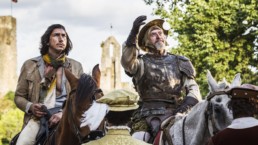‘The Man Who Killed Don Quixote’ Review: The Mad Gilliam Dreamer
This is a custom heading element.
When discussing the large range of dreamers, one could argue that director Terry Gilliam and Don Quixote are not listed far apart. For both of them, madness and dreaming seem to be one and the same, and their actions result in the gleeful entertainment for a reading or movie-going audience. The major difference being Gilliam’s clear awareness of his on-lookers’ expectations of madness and his masterful ability to play a self-referential magic trick, whilst hurling his protagonist and audiences narrative twists through differing character perspectives, before bouncing you through the fourth wall. This can be as subtle as a character knocking subtitles off the screen to show familiarity with their scene partner, or as drastic as inexplicably thrusting a protagonist head first in and out of surreal dreams that adopt another character’s impossible delirium. The result can be dizzying and confusing, but when on his game, Gilliam leaves a viewer feeling slightly crazy and asking things like; what in their world is real? And does that really matter?
The Man Who Killed Don Quixote presents an old man (Jonathan Pryce) fully immersed in the delusional fantasy of being the embodiment of the legendary Don Quixote of Spanish folklore, and a jaded director (Adam Driver) existentially searching for meaning before physically stumbling upon the tragedy he left behind when he was last there, shooting a film. The two characters are cosmically linked, in that through Toby’s (Driver) direction, Javier (Pryce) found his own personal “Don Quixote Madness,” giving the manifestation life.
However, it was also Toby who eventually claims the film’s title spot, reacting to his own hallucinations and accidentally killing his Don Quixote. In a fit of rage and grief, Toby calls out that the brave knight said he could never die, and fate seems to answer. The next scene, Toby displays his own personification of the mad defender of chivalry before riding into the sunset with a new “Sancho Panza” and code of values.
There are many parallels between Toby’s journey from lost arrogance to morally directed lunacy, and Gilliam’s long struggle to make this film. The project took nearly 30 years from conception to release, and so the idea of returning to ideas and locations where you’ve filmed and touched the lives of people is a strong correlation. As with anything, failed attempts can lead to frustration and Gilliam and his team briefly began shooting once in 2000. And in 2009, after a 9-year suspension, he continued writing and tweaking the screenplay with Tony Grisoni, who stated that they’d been re-writing the script on average, “twice a year, maybe more” since then. The process of revisiting ideas, some of which had failed or had unforeseen results, can be maddening especially when spread over three decades. Toby’s search for purpose and meaning in the insanity-stricken Javier’s charmingly righteous Don Quixote seems to mirror Gilliam’s pursuit of achieving a nearly impossible dream; to present his interpretation of beautiful innocence and chivalry that lies within one dreamer’s fantasy.
This theme of the deceptively wise mad-man has been present in many of Gilliam’s films. To name a few, The Adventures of Baron Munchausen (1989), The Fisher King (1991), Twelve Monkeys (1996) and Fear and Loathing in Las Vegas (1998), all have stories that dip into and often align with perspectives of characters that are declared insane within the world of the film. This suggests that the idea of higher morality and greater humanity can rise-above, subvert, or at the least remain independent of what society deems sane or logical.
In The Man Who Killed Don Quixote, Toby recognizes his sins when reflected back at him by the attendees of a costume party. Their cynicism, selfishness and cruel indifference to Javier’s mental affliction shame Toby and allows for him to embrace the magical and moral calling that Javier presented to him as Don Quixote. It appears more important to Gilliam to be outside the realm of social sanity than to sacrifice one’s moral compass for the sake of conformity in an immoral world.
The Man Who Killed Don Quixote opens at Arena Cinelounge this Friday.
Ryan Denman
Ryan is a contributing writer for CINEMACY.


